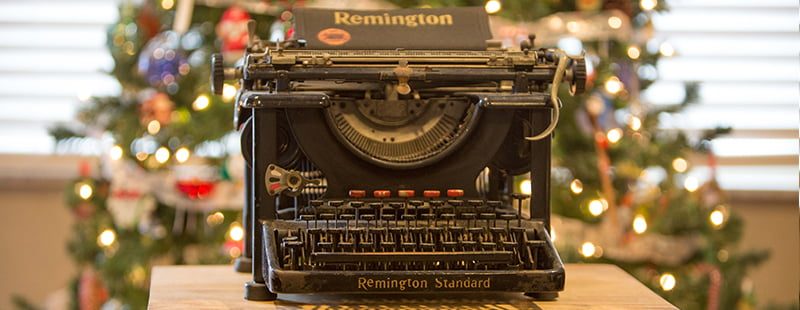 This may surprise you – I am a Typewriter and Old Camera Collector! I have always been fascinated by journalism and communications. That is probably why I chose Public Relations as a career path. All aspects of communications interest me, even the theoretical aspects.
This may surprise you – I am a Typewriter and Old Camera Collector! I have always been fascinated by journalism and communications. That is probably why I chose Public Relations as a career path. All aspects of communications interest me, even the theoretical aspects.
I love typewriters! And, I love old cameras! I do have collections of other communications tools such as old iPhones, movie projectors and slides, but for this blog post I have decided to reflect on a few of the reasons I decorate my office using various makes, models, and styles of typewriters. If you have a unique and old typewriter, camera or antique communication device, I’m interested in it! Please call me at 314-603-2866.
Typewriters are part of a rich journey through history
As far back as history is recorded people have been looking faster and more efficient ways to share information. In ancient times, cave writings recorded lifestyles and events for those who would later happen upon those caves. Since the invention of the legible alphabet, news and information has been recorded on dried bark, parchment, and animal skins, then transported across lands by horseback and across the sea in pouches of trusted seaman. In the days of Noah, messages, quilled onto small pieces of parchment, were strapped to the legs of doves, ravens and pigeons, then flown to, hopefully, their intended destinations. The birds were faster and more efficient, especially during war-time. I can’t help wondering what percentage of those flights actually reached their destination at all. How many people from different places do you suppose benefited from the information carried by the Pony Express, the seaman’s pouch, or the carrier pigeon?
Typewriters put more information in more places
Fast forward to the mid-1800’s and the invention of the machine that would change journalism forever. Christopher Latham Sholes, a mechanical engineer and printer/newspaper man, was the creative genius who introduced the “Qwerty” keyboard and invented the first typewriter to be mass produced. The idea was born out of the desire to create an automatic page numbering machine to aid in the print production of the newspaper. A friend to Sholes suggested that perhaps an automatic lettering machine be made instead.
Speed and efficiency had reached new heights. Entire manuscripts could be produced in short spans of time. Additional copies of those manuscripts could be produced and distributed. Later, the printing industry would also evolve in a way that multiple manuscripts would be produced without typing each copy. But for this time, the mass production of the typewriter also meant new opportunities for those who aspired to journalism as a career. Stories and information could be shared quickly, even while the stories themselves may have still been unfolding.
Typewriter design has stood the test of time
 Like most invented gadgets and gizmos, the design of the typewriter has been, for the most part, maintained. As a typewriter collector, that means there are lots of models I could add to my collection. But the point here is that we don’t have to lug 40 lb machines and reams of paper around so we’re prepared in case a story pops. Nor are we tied to a desk at a single location when we are compelled to compose a story or share information. While the mechanism has changed dramatically, the keyboard design has endured. Not only has it stood the test of time, it has, in fact, become an industry standard.
Like most invented gadgets and gizmos, the design of the typewriter has been, for the most part, maintained. As a typewriter collector, that means there are lots of models I could add to my collection. But the point here is that we don’t have to lug 40 lb machines and reams of paper around so we’re prepared in case a story pops. Nor are we tied to a desk at a single location when we are compelled to compose a story or share information. While the mechanism has changed dramatically, the keyboard design has endured. Not only has it stood the test of time, it has, in fact, become an industry standard.
Typewriters and Respect for the Story
Have I intrigued you yet? Good, that means I still have your attention after that brief history lesson. This next lesson is one I believe is relevant to journalism today and could possibly be the best lesson for the journalist or the professional communicator. Today, it is so simple to backspace, backtrack, delete, and start over when conveying a story electronically. But, as simple as it is to do these things, it is equally simple to throw information out to the masses that is destructive, inaccurate, and fuel for regret. How many messages have you sent out over social networks only to wish you had given more thought to the message or the purpose behind it? You could delete your message, but can you delete it in time? How often have you read a news story and later read a retraction of some of the detail? Again, easy to write a retraction, but is the damage already done?
The lesson I’m getting at is this… Think before you type! Typewriters were/are not as forgiving as computers. Misspells are not as easy to remedy as a simple touch of the backspace or delete key. Later models of typewriters did include some cool correction features, but such actions spoiled the pristine look of a clean error-free message. Error correction is only part of the lesson. Thinking before you type not only mitigates misspells and errors, it also allows for time to check facts, evaluate approach, and think thoroughly about the audience and the subject matter. Think carefully about what is going to be written before a letter is put to paper.
Bottom line – thinking through the content before hitting the keyboard is the right thing to do. This is especially true for the journalist and the professional communicator. When producing a news story for a client or writing content for a blog post like this one, the writer is responsible to communicate clearly, honestly, and effectively. The words, the thoughts and ideas, and how these are communicated all come with great responsibility. As a public relations communicator, I take this responsibility seriously. Having the desk in my office surrounded by typewriters, old and very old, is a good reminder of the importance of the work I do and the responsibility that comes with it. I would be dishonest if I didn’t add that these old machines and art pieces just look neat displayed in my office. It is the perfect blend of antique-meets-contemporary décor.



